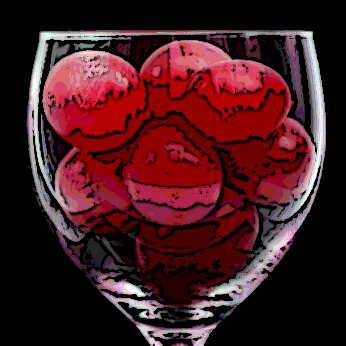Grape Expectations.
Chapter One, Part Three.
 Look, I know the drill. I’ve been there myself. You’re in a wine store reading those little signs in front of each wine when you start to feel out of place, kind of like one of those Duck Dynasty guys who mistakenly wandered into a gay pride parade.
Look, I know the drill. I’ve been there myself. You’re in a wine store reading those little signs in front of each wine when you start to feel out of place, kind of like one of those Duck Dynasty guys who mistakenly wandered into a gay pride parade.
Shelf talkers tout the virtues of the wine at hand, and usually contain a wine review from a magazine or newspaper. As you read how a wine “displays aromas of agave curd caressed by nuances of Louisiana road tar,” you find yourself thinking, “I never smell and taste these things in my wine.” You may have wondered, “What’s wrong with me? Am I perceptually challenged?”
If this sounds familiar, you’ve come to the right blog. WineSnark.com is here to ease your wine appreciation apprehension.
Right up front I’d like to correct a common misconception caused by these shelf talker wine reviews. No one added cat pee to your Sauvignon Blanc or horse manure to your Burgundy; they smell that way on purpose.
Really.
One of the great mysteries of wine is its chameleon-like ability to taste like so many things other than the grapes from which it came. Wine can be made from any number of fruits, but wines made from other fruits lack the variety of flavors found in grape wine. It’s as if this schizophrenic little cluster of fruit has multiple personalities.
Do you remember when you were younger and shared a bottle of apple wine with your friends? Did anyone rave about the complexity of the wine between retches? Probably not, because wines made from apples only taste and smell like apples (if memory serves – that’s true on the way down and coming back up). The same holds true for wines made from raspberries, cherries, blueberries and all the other fruits under the sun, all that is, except for grapes.
Wines made from grapes sometimes display aromas and flavors of grapes, but the characteristics are more likely to resemble apples, pears, black berries or cherries. Wine might also remind you of Darjeeling tea, smoked meat or hazelnuts. Grapes are like the Dame Edna of the wine world, they are great fruit impersonators.
So if you’re still wondering, “What’s wrong with me? Am I perceptually challenged?” The answer is no, there’s nothing wrong with you or your perceptions. Well, maybe there is, but if you don’t start commenting on these blogs I’ll never get to know you well enough to judge. You probably just need a little guidance, a couple of pointers and maybe some shock therapy. Meanwhile, this blog will put you on the path towards analyzing and describing wine just like the wine critics do.
I suppose you want to learn to analyze and describe wine or you wouldn’t have read this far (after all, 480 words is like the War and Peace of blogs). Maybe you just surfed across this blog while killing time before your doctor’s appointment, but you’ve read this far so I’ll keep writing and you can follow along even if you’re only killing time before your colonoscopy.





















I would love to learn more – on the level of Wine for Dummies to start please! So happy you have not disappeared from the wine world. I’m not a blogger but it must take time to get this sort of thing up and running – don’t give up!
Don’t worry Mary Ann, I’ll keep the blogs coming and dumbing it down comes naturally to me.
Sometimes I feel like I am the only one that doesn’t know what graphite tastes like, nor do I really want to.
Do these “tastes” change with time in bottle, time decanted…etc.
Went to the WS yesterday and felt like a kid crossing the street for the first time. Glad you are still around virtually to hold my hand.
Rob, I will always be around to virtually hold your hand. Just don’t ask me to do it in public.
Flavor characteristics can come from the grape, fermentation, oak, terroir, alcohol or tannin and they are constantly evolving. Once a bottle is opened and oxidation is expedited the changes occur faster. For example, the strong tea-like flavor from strong tannins becomes less apparent as the wine ages and the tannins fade. Sometimes a wine can have a strong graphite aroma combined with scents of cedar. Reviewers may refer to this combination as “pencil shavings” because the wine smells just like the mess that collects in your pencil sharpener.
I already miss all the great discussions we had at the Wine Seller and I’ve only been gone for a day.
My Boons Farm always reminded me of apple blossoms cascading down a waterfall of cat pee, masked by a pair of sweaty cowboy boots, and fermenting in 1970’s shag carpet.
That sounds vaguely like a night in 1972 that I’d rather forget.
Was that 1972, my how time cascades.